Last week school children of Australia marked the card of the Morrison government on climate change and gave it a fail. Was this too harsh?
On Q&A last Monday a Melbourne boy called Marco asked the panel:
- “I’m greatly concerned about my future and the future of children all around the world who will suffer the consequences of climate change more than anyone else,” Marco said.
“A few days ago thousands of students from around Australia, like me, went on strike from school to demand that the Government acts on climate change.
“When will the Government start to care about my future and children around the world by acting on climate change and create a strong climate policy?”

Q&A panelist, former South Australian Liberal senator Amanda Vanstone, said she was saddened by Marco’s perspective.
“It makes me sad to hear a young person say ‘people don’t care about my future’,” Ms Vanstone said.
“Both the major parties have got policies. They disagree about them. They both have policies. Emissions are coming down. Some people want them faster. But to just give the impression to young people that nobody cares I think is a bad thing.”
Marco was clearly not impressed. Nor should he be. Here’s the trend in emissions from the latest Quarterly Update of Australia’s National Greenhouse Gas Inventory: June 2018:
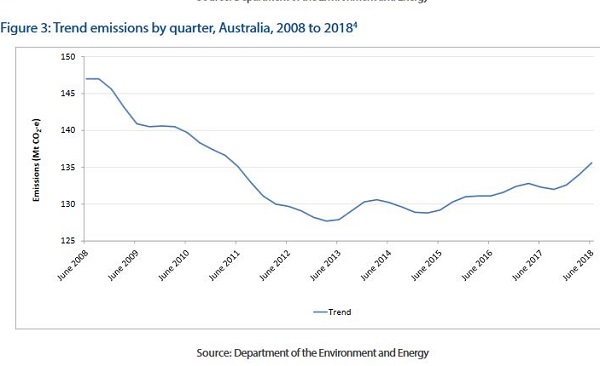
Up since Abbott junked the emissions trading scheme introduced by the Gillard government. And here’s the growth rate:
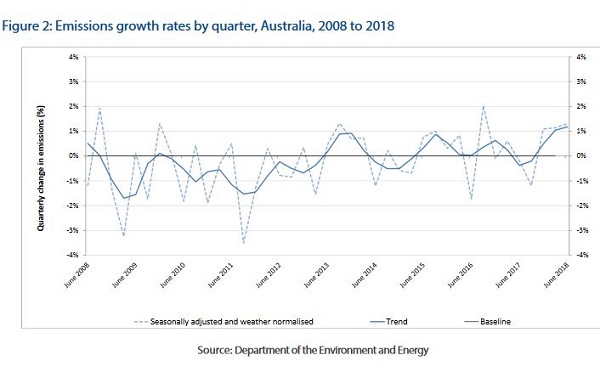
That’s the biggest increase for a very long time.
The Australia Institute have been doing a regular audit of our greenhouse emissions. Their latest Stay on target – Update, Nov, 2018 tells another story about Australia’s perfidy. First I’ll give you the graphs.
This is Australia’s longer term emissions story without LULUCF:
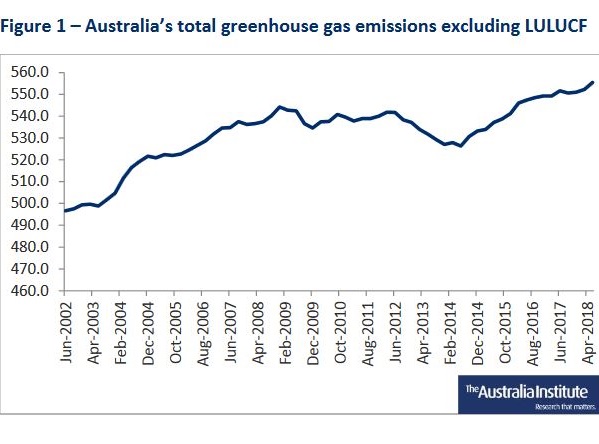
LULUCF is about land use and forestry. In Australia the biggest factor is vegetation management practices and legislation in Queensland. Here’s the graph with LULUCF included:
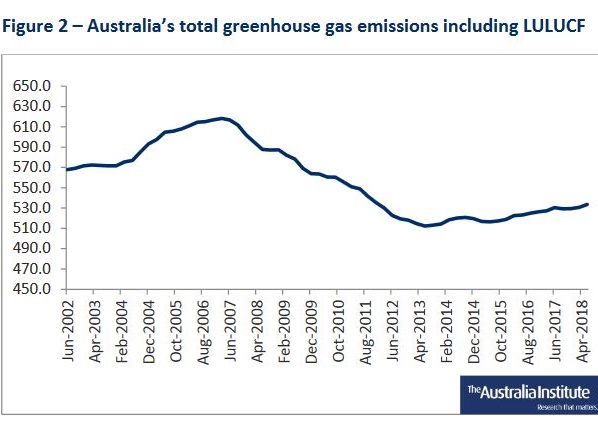
- During the negotiations for the Kyoto Protocol, while all other developed countries committed to reduce emissions, Australia – through a special deal negotiated by the Howard Government – was allowed to increase emissions by eight per cent over the period of 2008–2012 on 1990 levels.
The Howard Government also had an article inserted into the protocol that became known as the “Australia clause”, which allowed Australia to include carbon emissions from land clearing. This meant that Australia met its first Kyoto commitment by making small changes to land clearing laws. If we exclude changes from land clearing and land use emissions, over the first Kyoto period Australia’s emissions increased by 28 per cent.
I’m not sure I’d call the changes to land clearing laws “small”. Queensland farmers and pastoralists have a different story. To continue:
- Under the Kyoto Protocol, countries that beat their first commitment were able to bank and use those excess credits to meet their second commitment. With its special clause Australia easily reached its first commitment and was therefore granted these credits. At the Paris climate conference in 2015, almost all other nations, including the UK, Germany, Netherlands, Denmark and Sweden, cancelled those credits accrued from the first period – to send a positive signal of support for an ambitious climate agreement.
However the current Coalition Government did not cancel their credits and instead is using them to meet their second commitment target. Australia’s second commitment was to reduce emissions by five per cent on 2000 levels in 2020. With special credits from the first commitment, Australia is currently on track to meet that target.
According to the Government’s own emissions projections, emissions in 2020 will be the same as its emissions in 2000. This means that the entire five per cent decrease will be achieved from the credits received from beating the first Kyoto commitment. Those credits in turn were achieved not through reducing emissions, but through special deals that saw Australia achieve the target without any real changes and while increasing emissions over that period by 28 per cent.
Apart from the Rudd-Gillard years, Australia has put in a very determined effort to avoid its responsibilities. In relation to the Paris Agreement our commitment of 26-28% reductions by 2030 are pathetic considering our emissions per capita are more than double many OECD countries.
The government’s own Department of the Environment and Energy has done a projection of our expected performance in relation to our pathetic target. It shows that emissions will continue to increase, and by 2030 will be 128 million tonnes per annum above target. Here’s the graph:
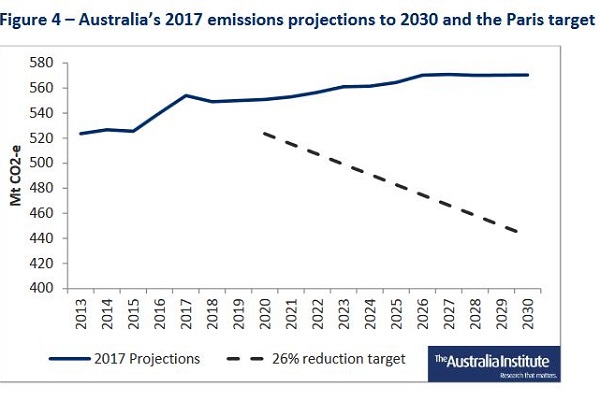
In truth, either they are asleep at the wheel, or they just don’t care. I’d suggest it’s the latter. From another angle, the Coalition have been acting like dishonest climate denialists. They pretend to care about climate change, but act as though it is no problem at all. And we are fooling no-one. Since Abbott became PM we’ve been champs at the ‘Fossil of the Day” awards handed out at the annual UNFCCC COP conferences (2018 currently underway):
-
The one achievement the Australian government can claim since the election of the Coalition government in 2013 is a virtual mortgage of the Fossil of the Day awards at the annual UN-sponsored climate talks.
The awards – handed out by NGOs united under the Climate Action Network-International banner, are handed out on a daily basis during the two-week negotiations, which in 2015 culminated in the Paris climate treaty, aiming to keep average global warming well below 2°C.
Australia has dominated the awards at the last few COPs (conference of the parties) ever since the Warsaw COP when then prime minister Tony Abbott ordered the Australia delegation to do an about-face on its previous negotiating stances.
However, looking abroad to see how the rest of the world is performing gives little comfort. Michael Davies-Venn takes a look at the state of play in The “Klimakanzlerin” Takes A Bow And Leaves A Vacuum now that Angela Merkel is winding back her role, not even attending the UNFCCC Conference of Parties (COP) in Poland.
Merkel, new in her job in 2007, scored when she got George W Bush on board at least paying lip service and participating in a multinational effort at the Heiligendamm meeting of the G7. Around the same time she performed the impossible in herding cats to get the EU to adopt meaningful targets. However, the reaction to the Fukushima nuclear meltdown was a serious misstep when she acceded to pressure from the Greens to elevate replacing Germany’s nuclear power stations to top priority. Hence:
Germany continues to burn coal with Merkel as chancellor. 20.68 Gigawatt (GW) of brown coal and 27.64 GW of hard coal were being burnt when she took office. Today, 21.20 GW and 25.05 GW respectively are still being burnt.
From this graph we can see that German electricity generation has been increasing by means of renewables, but so far, emissions from fossil fuels remain about the same:
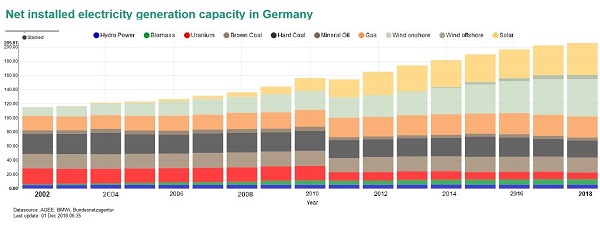
Davies-Venn’s summary of what other countries are doing reveal an alarming lack of effectiveness.
This year, as always, UNEP has done its Emissions Gap Report 2018: November 2018. From the Press Release, the main finding is that:
- It is still possible to keep global warming below 2°C, but the technical feasibility of bridging the 1.5°C gap is dwindling.
- Global CO2 emissions increased in 2017, after a three-year period of stabilization.
- If the emissions gap is not closed by 2030, it is extremely unlikely that the 2°C temperature goal can still be reached.
This is how the yawning gap looks:
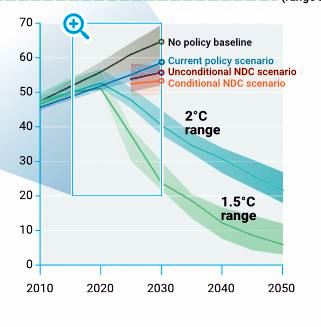
Here’s what the biggest emitters have been doing:
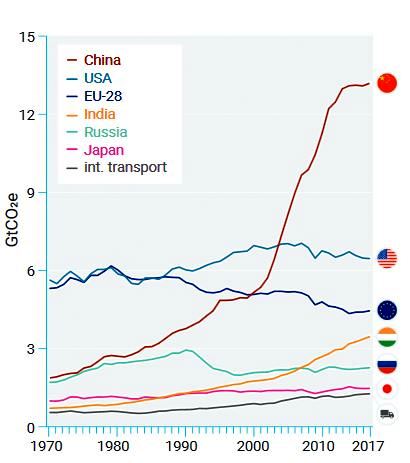
But it’s not just them. UNEP found that by 2020 some 53 countries, representing 40 percent of global emissions, will have peaked, if commitments are fulfilled.
By 2030 up to 57 countries only, representing 60 percent of global emissions, will have peaked.
If 2°C is to be achieved countries must raise their ambition by 3 times. To achieve 1.5°C, make it 5 times.
The biggest problem, though, is that as I explained in IPCC on 1.5°C: the target is wrong, but we have a strong wake-up call 1.5°C is the wrong goal. We don’t know what will happen when the temperature increases by 1.5°C. We know that the climate is already dangerous, and that sea level rise will continue for millennia. (See also Ice sheet decay spells danger from sea level rise.) We knew back in 2014 that the Game is up, there is no burnable carbon if we want a safe climate. In 2013 David Spratt warned that
-
“preserving more than 10 per cent of coral reefs worldwide would require limiting warming to below +1.5°C (atmosphere–ocean general circulation models (AOGCMs) range: 1.3–1.8°C) relative to pre-industrial levels”.
That is, with +1.5°C about 90% of reefs worldwide may well be gone. Do we seriously want to save the Great Barrier Reef?
James Hansen says we should turn the heat dial down to 350 ppm, that is 350 parts per million of CO2, and that assumes that other greenhouse gases will by neutralised. In effect, since additional greenhouse gases such as methane and nitrous oxide are equivalent to about about a quarter of CO2, or a fifth of the whole, he is saying, turn the dial down to 280ppm which is where it was before the industrial age.
So if you want to know how well the world is doing, check the graph at NASA:
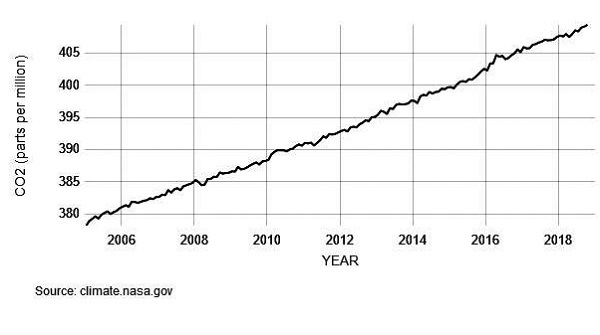
In October 2018 CO2 levels were at 409 with no sign that they had been stable for several years before 2017 as asserted by UNEP.
The point here is that UNEP calculate emissions by adding up reports from countries, which, if you check the actual atmosphere, turn out to be an underestimate. This is a problem no-one seems to be bothering about.
Another graph worth watching is ocean heat content, which I looked at in Climate clippings 226.
Upwards of 90% of the heat trapped by human-emitted greenhouse gases goes into the oceans, so this is one of the graphs that must flatten if we are going to have any luck in containing global warming:
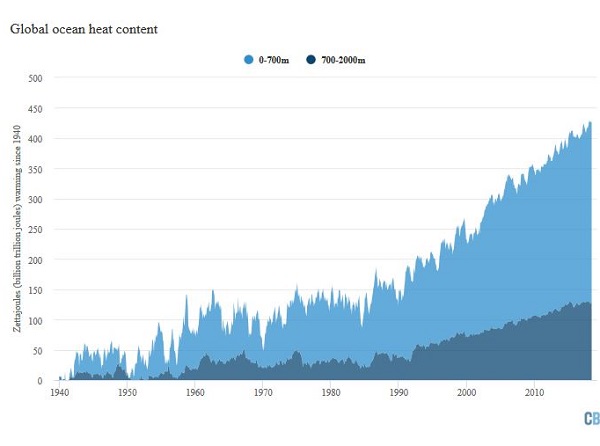
Unfortunately no evidence of progress yet. Heat from the ocean can be transferred to the atmosphere, especially in El Niño years.
An increase in ocean heat content will result in surface temperature increase over the medium to longer term, but not in a strict linear correlation. However, the overall relation of emissions to temperature is very strong, as this older Pew Centre graph shows:
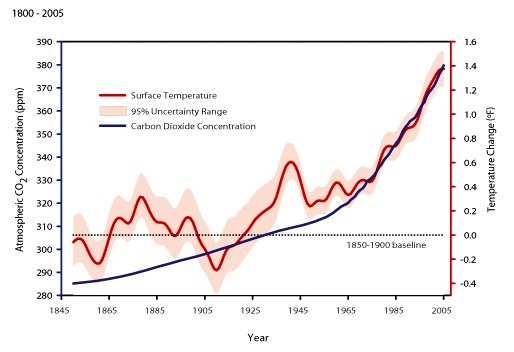
Temperature has progressed from there:
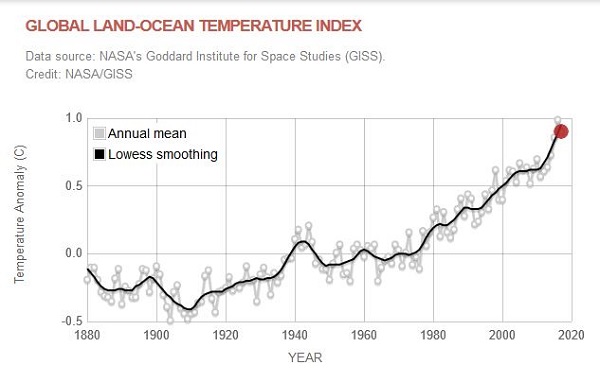
That’s NASA GISS 2017. 2018 is shaping as the fourth hottest on record globally. The 20 hottest years have fallen in the last 22 years. Anyone 32 years old has not experienced a single month below the long-term average.
All we can say is that things would be worse if we did nothing, but what we have done is not making a noticeable dent in the problem.
Back in 2014 in a post The road to perdition I said:
- We dawdle towards 2015 and 2020 while options close off or become harder. Perdition looms.
Recently when the Club of Rome launched its Climate Emergency Plan Hans Joachim Schellnhuber, professor and leading climate scientist, director emeritus of the Potsdam Institute for Climate Impact Research and a Club of Rome member said:
- “Climate change is now reaching an end-game scenario, where very soon humanity must choose between taking unprecedented action, or accepting that it has been left too late and bear the consequences.”
Frequently people who understand our predicament call for climate change to be tackled with the urgency countries adopted during the world wars. Recently David Spratt looked at what emergency mode climate action would look like. This is what happened in World War 2:
- A “whatever it takes” attitude means that government plans and directs the nation’s resources and capacity towards building up the war effort. This can be done at amazing speed. After the surprise Japanese attack on the US Pacific fleet at Pearl Harbour in 1941, the US economy was transformed from the world’s largest producer of consumer goods to world’s largest producer of military goods in a year. Government directed the whole war effort, but business boomed as the national economy grew quickly. The proportions of national economies dedicated to the effort in World War II were staggering. Military outlays in 1943 as proportion of total economy were: USA 42%; UK 55%; Germany 70%; and Japan 43%. Japan’s percentage reached about 70% in 1945.
That is probably 10 times what we need to tackle climate change in a fair dinkum way.
We have the technology and the resources, what we lack is leadership and political will. The children are right:
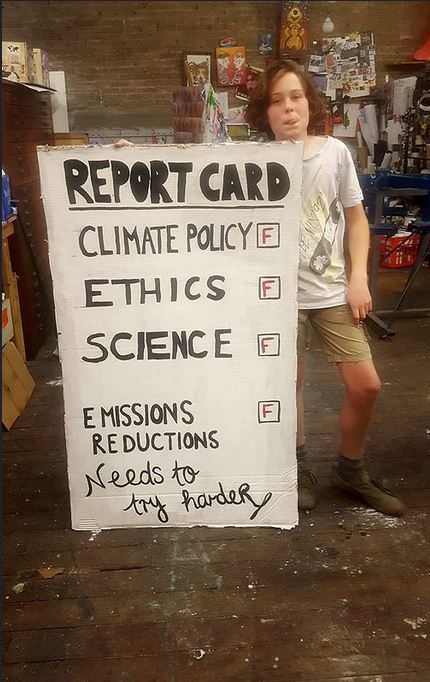
Update: The Global Carbon Project has issued its annual report finding that emissions from fossil fuels and industry have increased by around 2.7% in 2018, the largest increase in seven years. They identify major changes within countries, such as that the rise in Chinese emissions in 2018 was primarily driven by “government stimulus in the construction industry”, a sector which “emits lots of CO2”.
Also:
- Despite record sales of electric vehicle in the US – the total number just hit the 1m mark – there are nearly 12m more cars with internal combustion engines in the country than there were in 2008.
This is their scenario of where they think we need to go:
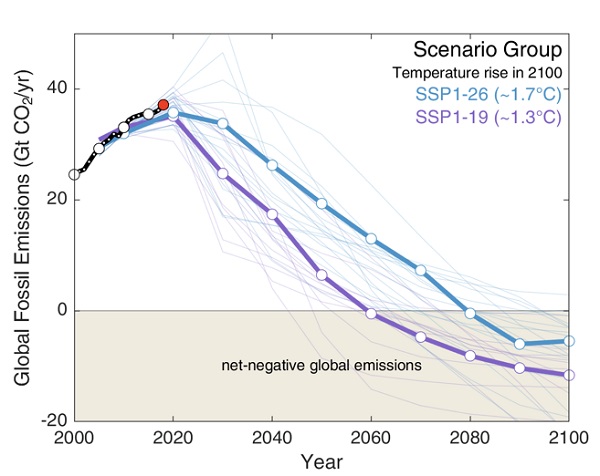
This appears to relate to fossil sources only, as the current total is less that 40Gt. The UNEP Emissions Gap report put greenhouse emissions at a record of 53.5 GtCO2e.
Elsewhere the UK Met Office Hadley Centre has done an attribution study on the summer heatwave, finding that global warming made the event 30 times more likely. So what would have been a 1 in 245 year event became a 1 in 12 year event. By 2050 they suggest the odds will be 1 in 2.
James Hansen once said we would take notice of climate change when we could see it by looking out our window. We can see it now, if we look. We should have listened to him back in 1988 when he told the US Senate. He got it right then, and got it right in 2007 when he answered Bill McKibben’s question by saying we should aim for 350ppm CO2e for a safe climate. It was galling to hear The Science Show talk of 1.5°C as the “ideal” scenario.
Finally, I forgot to mention what Paul Ehrlich said back in March:
-
A shattering collapse of civilisation is a “near certainty” in the next few decades due to humanity’s continuing destruction of the natural world that sustains all life on Earth, according to biologist Prof Paul Ehrlich.
He thinks the earth’s true carrying capacity is roughly 1.5 to two billion.


Post now finished. Unfortunately the accidentally published draft had quite a few glitches. If you find more, please let me know.
In Ian Dunlop’s submission to the Independent Planning Commission NSW (IPCN) concerning the Determination of the proposed Bylong Coal Project, he states (on page 2):
All the more reason to be exiting fossil fuels ASAP.
Brian, thanks for that To the Point summary, the writing is on the wall from a risk management position. There is increasing evidence our current political systems are failing us and humanity is at stake. There are increasing odds that, within foreseeable time all of us will have to deal with these profound consequences.
WRT to your stated “whatever it takes” war effort, it is pretty clear where our national defence leadership stands.
Here a US perspective
Here we go again.
Change the political system, i wonder what to exactly, hmmm that”s a tough one.
And be lead by military opinion and action.
Sounds familiar.
Some may think Global Warming is being used by folk with ulterior motives. I’m glad they make it so obvious.
History has shown that medicine is worse than any illness.
Jumpy:
I guess a blanket ban on medical treatment would dramatically reduce emissions and leave some interesting ruins.
Update: The Global Carbon Project has issued its annual report finding that emissions from fossil fuels and industry have increased by around 2.7% in 2018, the largest increase in seven years. They identify major changes within countries, such as that the rise in Chinese emissions in 2018 was primarily driven by “government stimulus in the construction industry”, a sector which “emits lots of CO2”.
Also:
Despite record sales of electric vehicle in the US – the total number just hit the 1m mark – there are nearly 12m more cars with internal combustion engines in the country than there were in 2008.
This is their scenario of where they think we need to go:
This appears to relate to fossil sources only, as the current total is less that 40Gt. The UNEP Emissions Gap report put greenhouse emissions at a record of 53.5 GtCO2e.
Elsewhere the UK Met Office Hadley Centre has done an attribution study on the summer heatwave, finding that global warming made the event 30 times more likely. So what would have been a 1 in 245 year event became a 1 in 12 year event. By 2050 they suggest the odds will be 1 in 2.
James Hansen once said we would take notice of climate change when we could see it out of our window. We can see it now, if we look. We should have listened to him back in 1988 when he told the US Senate. He got it right.
Finally, I forgot to mention what Paul Ehrlich said back in March:
A shattering collapse of civilisation is a “near certainty” in the next few decades due to humanity’s continuing destruction of the natural world that sustains all life on Earth, according to biologist Prof Paul Ehrlich.
He thinks the earth’s true carrying capacity is roughly 1.5 to two billion.
Brian (Re: DECEMBER 8, 2018 AT 12:10 AM)
In 1972, the Club of Rome published Limits to Growth, which included a “business-as-usual” scenario which suggested our civilization could possibly collapse some time this century. At around the time of publication it was generally derided, and some still do, including Bjorn Lomborg.
The Guardian article headlined Limits to Growth was right. New research shows we’re nearing collapse, dated 2 Sep 2014, includes:
The warnings have been given, and humanity continues to ignore them.
Ootz, thanks for the defence links. They have long been on board in the US and Russia. I’m sure the Chinese are up to speed also. This is a worry:
In short, said the UCS, U.S. coastal military bases face a “flooded future.”
A three-foot sea level rise is already considered by scientists to be “locked in.” But many researchers believe the world could be looking at rises of eight feet, and even up to 11 feet by century’s end, which would swamp pretty much all current DOD base adaptation efforts.
Given ice sheet destabilisation, I suspect 2-5 metres is what planners should be thinking about, and if they did, moving to a wartime emergency approach would be the only way of going.
Then there is this:
As a result, experts say, even as the U.S. military bulks up, its fighting forces are likely to face an exhaustingly high number of international conflicts as global warming devastates crops, shatters developing nation economies, increases the number of failed states, and leads to war after war—leaving the world’s future all the more insecure.
It appears Jumpy is at the fourth stage of climate denial.
Hahaha, what exactly do I appear sceptical of zoot ?
Other than the idea that turning against democracy because of something military leaders are concerned about, as Ootz is suggesting, will leave a wonderful legacy for our children.
History has shown, I will openly admit, that that* approach has slowed overpopulation.
* ( I’ll amend the twice quoted sentence which seems to have created misunderstandings around what was expressed. I’m afraid I’ll never be able to put thoughts to text like a librarian or engineer or… whatever zoot is/was.
“ History has shown that that medicine is worse than any illness. “
Hope that clears things up )
Sorry, it doesn’t.
Your statement as it stands says that any attempts to reduce climate change due to global warming will be worse for humans than letting global warming continue unchecked.
As I have lamented here before – the human race is too stupid to save itself. QED
Jumpy
Is that the case? Do you believe that human attempts to reduce global warming would/will do more harm than global warming itself?
Or is it only “the socialist road to carbon emissions reductions” that you strongly condemn??
Had you read the link and not just the heading you would have seen that the fourth stage is to deny we can solve it – in your case ‘because the cure is worse than the problem’, cf Roy Spencer and the poor. Sceptism has nothing to do with it.
Oh, it can be solved through democracy and capitalism, no doubt.
Through knowledge and free will.
If authoritarians and their sheep can get out of the way.
Listen, we’re not talking about “ saving da planet “, the planet will be just fine.
We’re talking about humans.
If the common genetic predisposition of human individuals is stupid and self destructive then why save us ?
I happen to think human individuals are smart enough and self preserving enough.
Until the Chinese have liberty and Capitalism then there “ efforts” are just a Potemkin village.
Read through the thread again. Nobody has mentioned “saving the planet”. Why do you bring it up?
No you don’t. You believe
The medicine Ootz is an advocate for zoot.
If that isn’t clear to you at this point then you’re capable discussing it honestly.
Incapable.
So what medicine do you advocate? (Please bear in mind that ‘free’ markets have brought us to this point)
BTW Ootz was agreeing with Brian (and I suspect most of us here) that the situation is dire enough to warrant extreme measures in response.
So you’re actually picking a fight with Brian. Just sayin’.
Sad news for your ilk, Jumpy. It IS about saving the planet and ALL of the living creatures. Democracy is clearly incapable of eliminating the threat. Capitalism is a medium not an entity, as is the free market, the latter being on its last legs along with liberty. America’s greatest and most successful Libertarian is getting closer to being arrested along with his despicable family, and rational people can get on with implementing real climate change action. Fortunately the horror experience of Trump has been so severe that global awareness to the destructive force of low empathy neoliberalists, nationalists, supremecists, libertarians, etc has been spot lighted in a way that makes the actions of these groups easier to detect and defuse.
The future will be a global battle field in so many ways.
Quiggin makes a good point
Yes you never can debate the Taliban of Jumpystan with facts and reason nor expect them to be able to engage with critical thinking. They have been brainwashed by the shock jocks of Murdoch and after dark madrassas and programmed to maintain the rage and anger against the infidel warmists.
I live in the deep of regional Queensland and I am surrounded by them. Everything is black and white, us and them, politics here is a blood sport, where allegiance to the cause is everything. Of course it is self defeating in the end, just like terrorism. The worst thing is that the regions will suffer disproportionately because of that. The voters in the more urban electorates will not take the regions seriously in their plight when it will come to the crunch, having lost all credibility. Further, the regions will also be less prepared and resilient to deal with multiple and rapid environmental, social and technological changes rural and regional Australia faces.
I suppose your “authoritarians and their sheep” was an indirect answer to my polite question at 5.51pm, Jumpy.
Who are these “authoritarians”?
A glimpse into the post collapse future (go to 8.18)……
https://youtu.be/HJu26X6b8p8
The construction industry of the future without climate action.
Authoritarianism def
Akin to rwnj section of LNP threatening to blow up their party, government, future of our Nation and even humanity with counterfactual and unreasonable propaganda facilitated by Murdoch, IPA and fossil industry. Where a few powerful self-interested characters brainwashing self-indulgent emotional populists while holding larger part of population to ransom, all for the sake of their distorted sense of Self and Freedom without any sense of dignity or consequences.
They adhere to a self indulgent culture which does not tolerate reflection and is so insecure, that any questioning of their rational is seen as an existential challenge which must be fought and eradicated. A culture who is prepared to eat it’s children, abuse, marginalise and kill its women folk and anyone not of their culture is the enemy, where rights and truth are solely owned by the cultural warriors. There is no room for reasoned debate and effective collaboration in Trumpys Jumpystan. Truth tm is solely owed by them and must be defended by all means. If that does not work, well they are prepared to pull the plug, see above @DECEMBER 9, 2018 AT 8:00 PM:
And yet, and yet, ootz…… Mr Turnbull came to the PM job, promising a “new, gentler politics”. He held out the prospect of wideranging discussion (“nothing is off the table”), decisions based on technical advice – whether engineering or financial – and rational debate.
Is that what we got from him and the Govt he led? Was it only after his “near death experience” at the 2016 election, that he swapped from rationality to short slogans?
Discuss.
David Spratt comments today at ClimateCodeRed.org, finishing with:
Fiddling while Rome burns.
On Turnbull’s “new, gentler politics” Ambi asks:
No, Ambi, it stared before that. Turnbull’s problem was that he didn’t form up new ideas before he put them out. So we had ridiculous thought bubbles (brain farts?) like the states should raise their own taxes.
Then in February 2016, it was quite precise, you can point to the day, he changed tack when Labor came up with its negative gearing/capital gains policies, carefully thought out and costed.
he said the housing market would be “smashed” when he knew that to be untrue. It has gone on from there. back to the Abbott style of one scare campaign after another.
There is not too much wrong with our political system. The behaviour of the people within it is the problem.
There was an interesting discussion Is democracy on the decline on Big Ideas.
We could improve, but the basic institutional structure is not under threat, as it is in some other places.
Brian
What’s ridiculous about that ?
The States run education, health and law enforcement, probably the top 3 election issues for most Voters for ages. They’re in charge of some taxes now, why not income tax ?
Brian
Thanks for reminding me of Feb 2016 and the Govt hysterics over negative gearing on existing dwellings (ALP policy against ).
So if his sloganising was a factor in his downfall, he began using it well before his 2016 election disaster. BTW I think Mr Turnbull was a poor campaigner and deserved the “thumbs down” the electorate handed his Party two years ago.
On the other side, Labor seems to have learnt about “disunity is death”, though that observation has been kicking around for many decades…..
I think one of the reasons some strong independents have a chance is that the big Parties still select some dud candidates.
This is a kind of a legacy thing,….I finally found some one who truly understands …….. ME.
https://youtu.be/Y4oydSZTAns
Fine work, Pam Ayers and BilB.
🙂
States being able to coercively appropriate sovereign citizen’s hard earned wealth for a start.
Interesting.
The Federal Government and the State Governments do that now.
You may be seeing it the Libertarian way at last.
Never too late.
Oh, just a little heads up, Australia is a Federation of States. Constitutionally we a sovereign citizens of our respective States first.
Jumpy: My wise wife always said when I complained of paying the top marginal tax rate that I was lucky to be earning enough to pay this rate.
There are worse things than earning enough to pay tax.
John
The debate is about which level of Government collects it for redistribution.
For what it’s worth, I would surmise your level of income had more to do with sacrifices, dedication, application and good decisions rather than luck.
I don’t believe the greens have yet proposed a luck tax, give em time.
BilB, brilliant!
Jumpy:
Not with me, it isn’t. My point was that Turnbull put out ideas which were not even half-formed, and then wondered why there was no serious debate.
That’s all.
Jumpy
Please be aware that taxes are based on simple arithmetic. The ATO is not concerned with the colour of your skin, your religion, your age when you left school, your opinions,….. No, it all comes down to the arithmetic of your wages, salary, profit/loss, turnover,….
You should know that; if you have an accountant, she certainly does.
The ATO does not assess dedication, hard work, or good decisions. It may be interested to hear of sacrifices, but only if the sacrifices have an associated expense that is an allowable deduction.
The ATO doe s not attempt to assess “luck”.
I agree with Mrs John, who saw that, on balance, it was better to have a high income tax debt, implying as it did a higher income.
Some higher earners actually are pleased to contribute financially through their income tax payments, or council rates, to the society which has supported and fostered their own financial success ( you know, trivial matters such as power supplies, roads, education, the justice system, garbage collection, hospitals and GP services…..)
Posted yesterday evening at the SMH online (& in today’s paper edition) is an article by Cole Latimer headlined NSW plans to supercharge pumped hydro. The article begins with:
The NSW Government renewable energy resources map can be found here.
I’m having difficulty finding the NSW Pumped Hydro Opportunity Map shown in the SMH article on the NSW Government website.
Jumpy: I was lucky to be born with brains to parents who appreciated the benefits of education and grew up at a time when governments and employers thought paying students to go to universities was a good thing.
Happy that people paid taxes that helped me stay healthy and get to a point where I made enough to pay taxes.
In terms of state vs federal taxes I think it is important to avoid situations where some levels of government can’t get the money to do their job properly or where one level of government pays the political cost of collecting taxes while another gets the political gain of spending the money.
Jumpy, This is the Western World wealth distribution reality…
https://youtu.be/QzQYA9Qjsi0
….and it is going to change, by one method or another. Even the 1% are embarrassed by their situation……
….and I’m certain that you don’t believe this. Please don’t take my word for it listen to one of the many 1%ers …….
https://youtu.be/WH1NihRN5cU
As Abigaile points out Trumps tax cuts are really about the next 3% clawing their way into the 1% to expand that group to 4% if only they can.
Posted yesterday evening at The Guardian is an article by Lisa Cox & Ben Smee headlined Adani met with environment department 40 times in six months, beginning with:
You have to wonder who the Federal and Queensland governments are really working for?
John
Quite right.
And wouldn’t it be more efficient if the entity that is charged with the distribution also be the entity that that collects ?
I don’t see how it’s efficient that, let’s say $1million destined for education, raised by the Fed and realistically has all the associated costs of first the parliamentary rigmarole in arguing its need ( duplicated by the States ) then going through the Federal Education bureaucracy machine looking more like $0.5 million and finally entering the State Education bureaucracy.
Eliminate that unnecessary step and all the duplication.
Same as roads, hospitals, Police, energy supplies, etc…
Purely from a practical economic perspective.
BilB, I don’t know what mathematically illiterate tangent you’re going with this time but the 1% can’t be expanded other than through growth in the sample size.
I’ll let Mr A spell it to you, I’ll stick to rational conversation with John.
By the way, if you earn more that $ 35k per year, you’re in the global 1%.
Struth, someone on the Australian dole is in the top 5%.
Find out where you are. and feel whatever shame you deem necessary.
As it stands, that’s a meaningless statement. Care to expand upon it?
I’d rather stick to the State/Fed tax collection thing discussion zoot.
But I’ll give you this, if there are 7.5 billion folk on Earth then the “ 1% “ comprises of 750 million folk.
When the World had 2 billion folk then the “ 1% “ comprised of 200 million.
I’m guessing that 95% of folk are worse off than you, and you can thank the folk better off than you for your position in the rankings.
But that’s just a guess.
Anyway, that’ll be the last distraction I’ll indulge in for today from your good self.
If that’s really the case you wouldn’t have bothered responding to Bilb, but no skin off my nose..
That’s pretty good for you – only out by a factor of 10.
A factor of 10, you say, zoot?
Please be aware that Jumpy has contracted me, as of 4.40pm, to advise on arithmetic. This is a binding and pecunious contract he has entered me into; as soon as I can ascertain his ABN, I will be forwarding him my first invoice [retainer, for the payment of]. Terms will be 20 days because the PM said small businesses like mine, Ambivalent Arithmetic Is Us, should not be used as banks by larger, more successful enterprises.
That sounds fair.
As soon as payment has been received, I will begin the onerous labour of explaining Mr Jumpy’s arithmetic to the poor and huddled masses, yearning to be free.
In the meantime, as you were.
Look busy, Jumpy’s about!
CEO and Company Secretary
AAIU
Unsurprisingly Jumpy you completely missed Pickety’s and Krugman’s revelation. Its about wealth concentration and the distortion of political power that creates, which ultimately results in further erosion of government financial stability as the wanna be privileged (conservatives) manipulate the taxation system for personal opportunity rather than public good.
Zoot
Haha, Touché !! , I don’t know what I was thinking, perhaps stuck in GST mode.
My point was even though the “ 1% “ has risen in number from 20 million in 1927 ( about when we hit 2 billion population) to 75 million, and the level of combined “ 1% “ wealth has skyrocketed, the abject poverty levels have decreased dramatically.
I can find no correlation that income inequality raises poverty levels where capitalism is adopted.
As far as Pikety and Krugman are concerned, what do they say about China and what caused the plummeting levels of poverty there BilB ?
Do they not have billionaires all over the place now that have close ties to government.
Could it possibly be they adopted some free market capitalistic qualities to be able the join the WTO ?
Anyway, seems like no one can rebutt my contention that the States should raise the revenue they ultimately spend, I guess we all agree that the notion is a good one.
So I’ll leave it there I suppose.
Wow, welcome to the dark side.
I never thought I’d see a comment from you in favour of taxation (of any kind).
Property is Theft!
Taxation is Double Theft!!
with apologies to various 19th Century socialists….
Zoot
What happened to “ States being able to coercively appropriate sovereign citizen’s hard earned wealth for a start. “ being ridiculous ?
I’m not a total “ never tax “ anarchist.
I’m leaning toward an across the board 20% flat tax on income, with a $40,000 tax free threshold. Abolish all the sin taxes and have Government not enter into areas that require them to spend more than that.
Id prefer the States collect it to avoid the wasteful step of having the Fed involved.
Clear delineation between State and Federal responsibilities and jurisdictions.
There’s also the out in the open black market trade at weekend and farmers markets that flout the rules and hurt businesses that comply. That’d be a State jurisdiction.
It won’t work, Jumpy.
You say you want:
1) the States to collect tax
2) the Govt which spends the money to collect the tax
3) “Federal responsibilities”
These three principles are inconsistent.
Would you care to tidy up, or outline again, your overall scheme?
You haven’t told us why it’s inefficient for the Canberra Govt to collect income taxes, if it is paying for
keeping Chris Pyne in Parliamentsubmarines and jet fighters, which are very expensive.By the way, a flat percentage tax is regressive, which some of us find regrettable. Do you?
Please explain.
Note to self: when you take the piss, it’s probably best to choose a target who has sufficient self awareness to realise they’re being sent up.
Mr A
Those are Federal responsibilities to purchase, why would I argue that the states should raise revenue for that ?
By the way, a flat percentage tax is regressive, which some of us find regrettable. Do you?
Please explain.
Well maybe, but there are a lot of regressive taxes that I’ve never see “ us “ express regret about. Tobacco and alcohol tax’s to start with.
Jeebus Ali Booda !! Something went astray there…
I agree that alcohol and tobacco taxes are regressive.
Jumpy , To have states collecting income tax would be to duplicate a complex system six or more fold and eliminate national conformity. This would then require people to learn new systems as they moved from one state to another. One national system works well.
A flat tax will never happen in a fair society. The top tax rate is already far too low and needs to increase. Making it easier for individuals to accumulate excessive wealth increases inequality, reduces economic performance, reduces the number of people who can participate in higher wealth (this means you Jumpy), reduces opportunities, increases population, decreases national health, reduces national well being.
You think your 20/40 idea is good policy, but in fact it is all bad. Paying tax is everyone’s responsibility so tax free thresholds should be a minimum.
You tend to think that keeping incomes low improves businesses ability to earn, when it is in fact the opposite. A wealthier population has a far more vibrant economy, and this in the highly mechanised world that we live in this has never been more true. The fact is that machinery does most of the work (powered at present by fossil fuel but this can very quickly transition to solar energy) the challenge is to share the income from that performance equitably across the population. Excessive wealth represents the ability to command more productive power is healthy as the impact is exponential.
You may think that you “chippie” operation does not benefit from automation, but the reality is that your world is highly automated. Gang nail trusses, nail guns, crosscut saws, HIAB lifters, site elevators, computers, utes, pre cut whole building packs,,,,. If you are not earning enough then it is because you do not command enough of the automation machinery applicable to your enterprise, and no amount of taxation reduction or cheap labour will help you because you just don’t understand modern industry economy.
Fortunately, for when you injure yourself and cannot operate your entirely multiplier devoid manual business our country has a taxpayer funded social welfare system that ensures that you are able to continue to live with dignity, or do you want to get rid of that too.
Combining a flat tax for most people with an UBI that pays something to everyone has the potential to be fair, much much simpler and progressive. (The UBI may vary with age but would not vary with income or assets. Assuming the UBI payment is high enough it would replace pensions, newstart allowances, child payments etc.
The rough figures I have done in the past suggest that it would be desirable for for taxes for very high incomes would still be enough to avoid the move to flat taxes becoming a rort in favour of the very rich.
BilB
Only were a Federation of States that can tax independently now, and do. They have a taxation infrastructure now.
I’m looking more and more at comparisons with the Nordic group ( prompted by Johns occasional references to the “ Scandinavian model “ ) and Australia.
Similar populations.
They have essentially 5 states and 4 territories.
Not much different GDP and per capita income.
Resources controlled by each state and plenty of fossil fuel resources for both.
Similar but differing taxation amongst their States as do our States.
Lots of “ interstate “ internal migration.
All the Nordic States collect their individual income and company taxes without too much bother.
Jumpy (Re: DECEMBER 14, 2018 AT 7:46 PM)
Per a recent post at Resilience.org (bold text my emphasis):
And further along:
At least Norway has had the brains to establish the Government Pension Fund Global, also known as the Oil Fund, established in 1990 to invest the surplus revenues of the Norwegian petroleum sector. It has over US$1 trillion in assets, including 1.3% of global stocks and shares, making it the world’s largest sovereign wealth fund.
Australia appears to fritter away our sovereign wealth.
And then some, our Debt is over 1/2 trillion and the monthly interest payments must be toward $1.5 Billion.
Our Future Fund ( set up by Costello when we were debt free ) is performing brilliantly but doesn’t cover the interest.
What is this, Jumpy? Have you given up Chippying and gone into Fruitpicking as a career? You admire the Nordic states for their tax collecting methods, but from all past reports completely reject their social welfare systems. Cherries and Apples.
BilB, I’m not a chippy, I didn’t express admiration for the Nordic tax system and their welfare system I don’t know enough about to completely reject it.
But please continue to imagine up an enemy to cut into, it’s very amusing.
Getting back to legacies, one of the greatest legacies to our progenie are some of the technologies that the science driven baby boomers have created. These are quite profound, but one of the greatest is also the most maligned by the Denislists who seek to continue to wallow in their wealth at the expence of the future well being of the biosphere and ALL of its inhabitants.
I have pointed this out elsewhere, but I emplore you all to look at this and understand its profound nature (this is my responce to an excellent youtube posted by MSNBC). This is not a gimmick or a handy thing to be used once in a while, it is the fundamental resource upon which our current and future wellbeing hangs……..
“For those who claim the science is fudged for personal gain, I suggest that they, as well as all of us, look at the app windy.com . This piece of software allows everyone on earth to see what is going on in the biosphere everywhere on our globe at any time from 45,000 feet right down to a depth in the oceans. This software is a window into the global knowledge on atmospheric and oceanic knowledge providing air temperature, pressure, humidity, wind intensity, direction, gusts, rainfall, snowfall, lightning, ocean waves, direction, tides, currents, temperature. AND everyone can test whether this information is correct at any one time simply by going outside and looking at what is going on. There are millions of people around the world who depend on this information, and that this information is correct. Every aircraft that leaves the ground and their passengers depend upon this information for their safety, every ship that leaves port and travels on the oceans depend upon this information to protect them from dangerous conditions that would threaten the vessels, the crew, and the cargo, The global economy depends upon this information being correct. I could go on for some time pointing out how our climate scientists, and our science community in general works tireless with amazing professionalism and dedication to make all of our lives better and safer. Yet we have to suffer a handful of politically motivated deceivers and corrupt politicians who in their mind bending ignorance want to deceive the broad public into thinking that scientists are scam artists. I personally call those people who knowingly set out to corrupt the understanding of our climate peril and to prevent action to address this unprecedented risk to our future safety, Criminals of the lowest order and Criminals who must be brought to account, and that includes this disastrous Climate Denialist president, Donald Trump. Active Climate Action Obstruction, and Collusion to Obstruct should be added to Trump’s legal jeopardies, and the fact that this is not yet a chargeable offence needs to be corrected in the next Congress…retrospectively.“
PS The government report card (as imaged above) is still the most perceptive comment of recent time.
OoH? Not a Chippie? I could have sworn I heard you call yourself that a number of times. But,..I happy to be corrected.
Not that it is really any of my business, but as we talk about other people’s occupations and I have been open about what I do, what exactly is your field of personal enterprise/experience Jumpy?
I have 3 Trades, painter, tiler and plasterer. 2 of which are considered finishing Trades. I have often said I work in the Construction Industry, never a carpenter.
Perhaps you filled in nonexistent planks with incorrect notions and believed them.
And you ?
Not that it matters when ideas are being discussed but in the interest of reciprocity.
In fact even a totally useless “ disability pensioner “ with bugger all qualifications can hold ideas that are more correct than career academic in that field.
Uhuh, not a chippie. Maybe I did fill in the blank, but 3 trades all requiring knowledge practice and skill, and together delivering solid commercial agility. Very impressive and all skills I do not do at all convincingly if at all, so I admire your contribution to the economic mix.
Me? I thought that that was spelt out long ago. I am a product designer, inventor, entrepreneur, manufacturer, soon to be semi retired as a yachtie cruising the canals of Europe and sailing around the Med (as long as our boat doesn’t sink). One product that I have manufacturered that is nationally visible are the donation collection panels in McDonalds drive throughs (now looking a little tired) in Australia, NZ, the UK and some in Europe, some 4000 of them altogether. That was just a CNC machining contract that kept us busy for 8 years. But it was to do one process on that job that caused me to invent a product that is now globally available and for which we now have some 30 international competitors, and that is a long story. But as I change my focus to things marine, I am creating a whole new range of ideas that will be embraced in a marine providoring exercise based in the Netherlands.
I do agree with you in that no-one has a franchise on good or correct ideas. I admire people who get out and do creative things with energy and conviction. It doesn’t matter what (apparent) level they are it is the doing relative to ones abilities and the self rewards that are the power (of course with focus for the common good).
One of the highest achievers that I have ever met was a guy I met in Sydney when we were both doing process work in a furniture factory in the 70’s. http://Www.primaryschoolsforafrica.com
Posted this afternoon at the AFR by Ben Potter & Simon Evans is an article headlined COAG energy meeting: Tempers flare as Angus Taylor blocks NSW ‘net zero’ plan. It began with:
Earlier today in the AFR, Ben Potter reported in an article headlined Gladys Berejiklian splits from ‘out of touch’ Scott Morrison on energy, targets net zero emissions, that:
Why have the NSW Gov raised this fact now? Excuse me for being a tad cynical: Is there a NSW election coming soon? Interesting times!
Geoff M, thanks for keeping us up to date.
Apparently at COAG they don’t need unanimity, they need five in favour for a decision to be actioned.
The proposal from NSW came at the very last moment, and other states had not been briefed beforehand. NSW had been talking to the media rather than to their colleagues.
To me that means they knew it wasn’t going to get anywhere, so essentially it was a stunt, designed to distance NSW Liberals from their toxic political kin in the Federal sphere.
However, it’s good to see that they saw this as a stunt worth pulling, and behind the stunt there is a commitment and awareness of the need for urgent climate/energy action.
Brian,
The NSW Shadow Minister for Energy and Climate Change (and Industrial Relations, and Industry and Resources), Adam Searle MLC, was on Radio 2GB yesterday afternoon with (coal and nuclear power booster and anti-renewables) Michael McLaren (temporarily hosting the Chris Smith Show). I thought Searle made quite a few good statements.
But (provided I understood his statement correctly from around time interval 13 minutes into the podcast), I do have a problem with him suggesting that, provided the design and engineering is optimized, pumped-hydro can deliver more energy than it consumes. Pumped-hydro technology inherently consumes more energy (in the pumping phase) than it reproduces (when in the hydro-generator phase) – turn-around efficiency for ‘Snowy 2.0’ is of the order of 67-76% (See RenewEconomy article “First thoughts: Snowy 2.0 will lift emissions without more renewables”, 21 Dec 2017).
I think that it is disturbing that an alternate NSW Minister for Energy still appears to be demonstrating a poor understanding of some aspects of energy generation technologies, and he may be making decisions about energy policy in a few months time. Who’s advising him?
Following Adam Searle’s interview, Queensland One Nation leader Steve Dickson called in to Radio 2GB to make some comments. Dickson raised the issue of the risk of volcanoes erupting, blocking out the sun, that could render solar power inoperable. Dickson apparently conveniently ignores the contributions of wind still being available in this circumstance. I would think if volcanic ash in the atmosphere was so bad that it blocked out the sun then that would also have a major impact on agriculture and food supplies. I think Dickson is using a straw man argument. It would be laughable if this argument was coming from some random guy, but this is coming from a politician running for a Senate seat for Queensland in the upcoming elections.
GM: Pumped hydro may produce more power than it receives if the upper dam receives run-off from rainfall, which would normally be the case. The minister may have been referring to this. I would assume many of the pumped hydro opportunities in NSW would fall into this class.
John Davidson (Re: DECEMBER 20, 2018 AT 5:03 PM)
Would that be the case, John? Do you know that for sure? Is there data available indicating:
– How much energy was consumed to pump water up to the top reservoirs in the Snowy Hydro scheme over the last year (say, or perhaps look over longer periods)?
– How much energy was produced from allowing water to flow back through the turbines over the same period?
Answers (from credible data) to these questions would confirm (or repudiate) your assumption. Data should be our guide; not assumptions that may well be wrong.
You appear to be jumping the gun, John. Adam Searle MLC is currently NSW Labor’s Shadow Minister for Energy and Climate Change, but if Labor wins the NSW state election in March 2019, he may perhaps be a Minister in the new government, in a few months time.
Not necessarily. It depends on whether the top reservoirs have any significant catchment (i.e. being on-river). Professor Andrew Blakers’ pumped-hydro reservoir pairs study has been to identify off-river sites with high head because there is no need to engineer expensive spillways to deal with floods. See YouTube video 2017 CURF Annual Forum – Andrew Blakers keynote, from time interval 13:38.
The NSW government report that Adam Searle refers to (from time interval 13:30 in the interview podcast) yesterday on Radio 2GB with Michael McLaren, I suspect, is based upon ANU Professor Blakers’ team data.
GM: Use your mind instead of making mindless demands for data and references.
If a river is flowing into the upper dam of a pumped hydro system the power generated from the water flowing down the river is a bonus.
John Davidson (Re: DECEMBER 22, 2018 AT 10:15 AM)
It seems to me you take the lazy approach, avoiding research and relying on baseless assumptions – is that right, John?
It seems you failed to watch or take on board the statements by Professor Blakers in the YouTube video link I provided in my previous comment. Dams that are on-river need to cope with floods, and are therefore more expensive to build, so that the dam won’t fail in a flood. Dams that are on-river usually offer lower head heights, and thus provide lower energy availability. That’s why Blakers looked for off-river sites because they offer cheaper build costs and higher head heights – less build costs, shorter construction times and higher energy output return.
I listen to or read what the experts are saying and draw my conclusions from the evidence/data given. What do you do John?
Claim-
Status- True.
Status- Refutable.
Jumpy: I think that catches it.
Pumped hydro has a turnaround efficiency of less than 80%, so upper system water contribution assists with the efficiency losses first.
The advantage of pumped hydro is that, where there is generation capacity that would go to waste, ie wind storms, it gives the capacity store that energy. The other factor is that river system flows are seasonal so the pump up part of the system improves the overall functionality of a hydro investment.
I have’nt read this and it seems to have a negative tone but there is a huge amount of information in it, more than Malcolm Turnbull ead on he subject:
https://dothemath.ucsd.edu/2011/11/pump-up-the-storage/
GeofM your Blakers comment is entirely circumstantial. Dams are rarely limited to one function. Warragamba Dam for instance had a power station that has sat idle for decades because we drink the water faster than it can arrive, mostly, so the flooding comment is only a partial consideration. The real issue with dammed rivers is silting losses, not wall strength cost. Wall cost is a function of the wall cost to reservoir capacity divided by the achievable head.
Pumped hydro calculator
Storage density is low. (3600 m3 falling 100 m generates 883 kWh=4.1m3 per kWh.)
JohnD that is the same as the figure I read years ago which was 227watt hours per 1 cubic metre at 100 metre head pressure.
Bilb: 41 tonnes of water (41,000 litres) falling 100m to keep our house running for one day (11 kWh)
I agree with your estimate of 41 tonnes, John D.
(Can we please have that in the official Aussie journalists’ units of “Olympic swimming pools”?)
😉
Its about a third of an olympic swimming lane, Ambigulous.
Roughly 1/24 of a pool then,
Or 0.04 swimming pools.
At least that removes difficulties with powers of 10.
I remember a few years ago, “The Age” reported Melbourne dam levels, and quoted the deficit as so many mL (millilitres) instead of ML (megalitre).
Only out by a factor of 10^9
or a thousand million.
I sent them a letter to the editor, saying Horace and I were happy to bring a few drink bottles of water down to the big smoke, to help out. They didn’t print it.
What’s a thousand million, between friends?
What’s a capital letter anyway???
Ambi, multiple zeros confuse me, but one tonne equals 1,000 litres, I think. It’s how the tonne is derived, from the metre, which itself is 1/10,000th of the distance from the equator to the North Pole.
Olympic swimming pool:
I think that makes 1/2500th, but as I say, I get confused and could be wrong.
Keep in mind that pumped storage needs a reliable supply of water to make up for evaporation and seepage losses. Like wind power, pumped storage may be vulnerable to climate change driven changes in weather patterns.
Sea water pumped storage will avoid the water loss problem but there may be issues with salt water contamination of the water table.
Evaporation is quite significant. I understand that hereabouts it’s about 1.8 metres pa, which is about 50% more than precipitation.
Oops, mine was a guess. In the light of more information, 1/12th of an olympic swimming pool lane to keep keep Ambi’s house lit.
2.5 * 2 *100 /41 =12.1 . I was only considering the lane not the whole pool.
Ahh, we all make mathematical errors from time to time.
Except those that don’t even hazard to try that is.
All good.
The first comment was a guess or assumption, but the second was an error, because the more correct answer is 2.5*3*50/42 for an answer of one ninth pool lanes the keep Ambi’s lights on. Olympic pool not 100 M long.
Brian: Map of annual evaporation rates for Aus 1000mm/yr looks a bit low for much of Aus. The rate at Telfer was over 4000/yr, The figure for my tailings dams near Newman would have been over 3000. (That is annual average. Newman gets frost and ice on windscreens during winter)
BilB (Re: DECEMBER 22, 2018 AT 8:52 PM)
And you are being rather vague in your statement. Please be specific – which Blakers comments are “entirely circumstantial”? Of course, being vague makes it a hard target to counter-argue, but perhaps that was deliberate?
Warragamba has one turbine with a generating capacity of 50 MW of electricity – I think it was hardly worth the effort to build it. The power station was completed in 1959 and is now disconnected from the electricity grid.
Multi-functions for on-river dams (i.e. power station and irrigation/drinking water supply) have conflicting requirements. Irrigation/drinking water supplies (particularly during droughts) requires preserving water, which reduces or prevents power generation – not good for reliably supporting the electricity grid.
I note that today, Sydney Water’s total water supply is at 61.2%, falling again at 0.4% per week.
But you have all conveniently ignored Blakers’ statement that on-river pumped-hydro offers significantly smaller head heights (repeated on multiple occasions in my comments above, but apparently unheeded/ignored by you) – that means less energy and power available in hydro-generation mode. Also, there are many, many more (i.e. 99 times more) off-river sites to choose from in Australia, compared with on-river sites. Much, much less sites available with much less generating capacity – a mere technicality, eh?
Really, BilB? There’s much more than wall strength cost for on-river dams. There are expensive flood mitigation measures including spillways to protect the dam wall from over-topping during flood conditions (repeated multiple times in my comments above). And you seem more worried about silting – please spare me!
All this information has been highlighted in Blakers’ 2017 YouTube presentation, but your (i.e. Jumpy, John Davidson, BilB, Ambigulous, and disappointingly even Brian’s) comments indicate to me you appear to have ignored these. These seem apparently irrelevant to you – your comments suggest what would Blakers know about the technical pros and cons of on-river and off-river pumped-hydro, evaporation rate management, etc. – you seem to have ignored them? It seems to me you are following John Davidson’s earlier comment that this is all “mindless” data and references – it looks like supreme hubris to me! Get real people!
Happy New Year – 2019!
GM:
What isn’t said here is that this may be true on average. However, there are plenty of rivers that run over high waterfalls (or lose elevation quickly) and may be logical locations for pumped storage systems that take advantage of river flows.
Don’t ask for a reference. The statement, like many of the things I say is based on personal observation/thinking.
John Davidson (Re: JANUARY 3, 2019 AT 12:41 PM)
Wow. No references allowed – just take your word for it, even when experts in pumped-hydro (i.e. ANU Professor Blakers and his team) says differently. It suggests to me you think you know better than Professor Blakers – that’s bold or foolish/delusional – I think the later condition applies to you.
I’d pay far more attention to Blakers and his team unless you could provide compelling evidence to contradict Blakers’ work – I won’t be holding my breath in anticipation of this happening.
Your statements also suggest to me you are at risk of being affected by a cognitive bias known as Dunning-Kruger effect. It’s something we should all be aware of succumbing to, and safeguarding against.